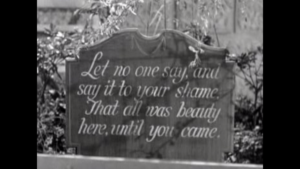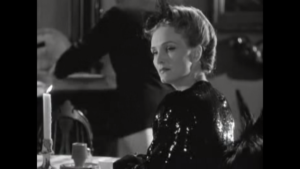Cat People (1942)
This movie from 1942 was remade–sort of–in 1982, as a wildly different animal. We’ll be reviewing that one soon, but for now, here’s our take on the original, with three two interpretations.

Prod. Val Lewton. Dir. Jacques Tourneur.
Cat People the elder is a polished, well-made movie from a time that appreciated the simple craft of film-making. It tells a deceptively simple story about four people and one panther, and the bit characters that drift in are characterized really deftly. It begins with a quote:
“Even as fog continues to lie in the valleys, so does ancient sin cling to the low places, the depressions in the world consciousness.” The Anatomy of Atavism– Dr. Louis Judd
This opening quote is so awesome, the only disappointment was realizing, when he shows up in the movie later, that Dr. Louis Judd is not a real person and I can’t track down this book and read it.
The movie proper starts with a Meet Cute outside a panther cage at the zoo, where Irena (Simone Simon) is drawing the panther and failing to throw her crumpled firstfruits into the garbage can. Her future man, Oliver (Kent Smith) (but let’s call him America), corrects her LITTERING SIN and points to the sign that says “Let no one say, and say it to your shame, / That all was beauty here, until you came.”
The fact that we would just write “NO LITTERING” now, or pictographs to that effect, shows an actual non-imagined decline in us as a culture. Greatest Generation IN-DEED.

Adorbs
America carries Irena’s… stool? (an artist’s stool for painting panthers) back to her apartment and gets himself invited up for tea. He stays till dark, when they can hear the lions roaring from the zoo; apparently Irena can hear them many nights, but she doesn’t mind because “to me it’s the way the sound of the sea is to others: natural, and soothing.” He asks about the statue she has of a mounted man with a cat impaled on his sword, which she says is King John of Serbia, who cleared the evildoers and witches from her village, though stories about them remain. He gets her a cat as a present, as one does when someone tells you that cats symbolize evil and witchcraft in their culture. Two scenes later they’re married.

“You’re so normal, you’re even in love with me, Oliver Reed, a good plain Americano.” – actual line
Once married, we find out that she believes that something evil in her will come out if she becomes physically intimate (the movie adorably 1940ses around what it’s really talking about) and America is willing to wait seemingly forever (forever turns out to be about a month of no sex) for her to get through this fear.
He gets her hooked up with a psychiatrist (Dr. Louis Judd, of opening quote fame) but she only sees him once. Dr. Judd is a true doctor, who says things like “Sometimes there is a psychic need to unleash evil into the world,” and generally seems to be from the 1890s instead of the 1940s, talking like Lord Henry Wotton and carrying a sword-stick.
Meanwhile she becomes jealous of America’s closeness with Alice the New Woman, his coworker. She stalks Alice in pantheress form through two of the coolest sequences of the movie (!!!!): one where Alice thinks (correctly) that she’s being followed down the street, the other when she goes for a swim in her building’s indoor pool at night, and Irena follows her down. The first scene ends with an amazing sound effect, where they make a bus coming to a stop sound like a panther roaring, my single favorite touch in the movie. The pool scene is ominous and they have fun with shadow and the weird, echoey acoustics of the pool. (GOD THIS IS SCARY – it really gets that childhood fear of a panther being in your swimming pool.)

Irena keeps revisiting the panther cage at the zoo, and passes up an opportunity to take the key from the absent-minded janitor. Dr. Judd pops up to psychologize her:
“You resist temptation admirably.”
“Temptation?”
“The, uh, key.”
“Why would I want it?”
“For many reasons. There is in some cases a psychic need to unleash evil into the world, [pretty much why we started this blog, really] and all of us carry within us a desire for death. You fear the panther, yet you’re drawn to him, again and again. Couldn’t you turn to him as an instrument of death?”
. . .
😀
“I don’t think you can help me. You’re very wise, you know a great deal, yet when you speak of the soul you mean the mind. And it is not my mind that is troubled.” [<- she never lied to us, you see? (See Interpretation II)] <3

Later, our noble doctor decides to enact his own “desire for death” by kissing Irena, provoking her to maul the shit out of him, though in the process he leaves his broken-off sword blade in her. She runs to the zoo and lets out the panther, falling dead as he leaps past her. to be instantly struck by a car. When America and Alice get to the scene, they find her dead in panther form, and America utters the movie’s final line, “She never lied to us.”
This is a top notch b&w drama that spirals into some murder-panther shit, but not in a “twist ending” kinda way, rather a “this was meant to be” way. For what it is I can’t imagine a better version of it. For every Sherlock Holmes that promised supernatural but then had a ‘logical’ ‘explanation’ for it, this one delivers.
Interpretation I: Panther Lesbians (Alexander)
Here’s the lesbian angle, in brief:
Irena finds that in modern America, there is a certain picture of domestic happiness she’s supposed to achieve. Man & woman. She wants it in that she likes Oliver personally, and because she wants to be happy.
However she feels there is something inside her, something in her nature, that bars her from that domestic happiness, and specifically from the sexual side of it. The other cat woman who greets her as “My sister” recognizes her at her post-wedding dinner and Irena denies her; based on the timing, it’s as if her sisterhood of the traveling panthers is a presence appearing to threaten her marriage, which she shoves aside.

Let’s notice the actual effects of Irena’s “affliction”, as opposed to what she says about it:
When it comes to Oliver, it prevents her being able to go to bed with him and prevents their domestic happiness, but he never causes her to turn into a panther.
Her panther side actually comes out for Alice, which the movie justifies by having her list of triggers suddenly include jealousy, and requires (it being made in the ‘40s) for Alice to be in love with Oliver. But primarily Alice is the career woman*, the one-of-the-boys woman, etc. Cough lesbian. So it seems like Irena’s much more “excited” by Alice than Oliver, and subtext-wise maybe jealous not of her relationship with her husband, but of her seeming to be self-accepting and sort of “out.”
(Forgive me.) Note also the PHALLIC SYMBOL! PHALLIC SYMBOL! imagery associated with the repression of Irena’s panther side; the statue of a King impaling the cat with a sword, and the drawing of hers we see at the end of the first scene, not of just a panther, but rather a panther being skewered with a sword! (I will remind you that for any movie with scenes in a psychiatrist’s office, all the psychosexual shit is on the table.) Also Dr. Judd, who’s aligned with the repression as the psychiatrist brought in to “cure” her, has a swordstick (it’s a sword and a stick!) which he–sort of–kills her with. At least, it get stuck in her, and she dies; symbolically it’s more like rape + suicide than a good plain American murder.

It’s a penis!
I could say more about this, the more I write about it the more it makes sense, not as the singular aha! interpretation, but one interpretation that does actually pan out really well.
*although Irena has a career too, but that feels more like the typical you-work-till-you-find-a-husband schtick.
Interpretation II: Pantherstition (Concurrence)

And so but my (and my) [our] actual main interpretation of the movie is about Old World superstition and religion vs. fancy New World American “scientific” reality, a classic “technology … vs. horse” story. This has less bits of cutesy “evidence” than the lesbian reading, but is still stronger because it doesn’t need them: it corresponds to what’s actually happening on the literal level of the story. Irena really is from the Old World, she really is in the grip of a spiritual superstition. Her stories of witches and curses can’t survive modern life in New York; when she lets the panther out of its cage, it’s immediately flattened by a car. When the pool lights go back on, she’s just a woman and there’s no panther there.
And yet as the movie’s last line says, “She never lied to us”: the movie doesn’t force her to be wrong and slap itself in the face with the dead fish of a rational explanation. The story can’t let her survive modernity but can’t deny her validity either. Specific beliefs may not always stand up to the light, yet still resonate with something true and frightening, that most people would like to push aside and traipse onward in their happy American middle-class lives; perhaps with the reality of the spiritual in some form. Dr. Judd would prefer to say, with deep-repressed psychological urges towards death and darkness, with atavistic ancestral fears of predators and the dark … and he calls himself a psychiatrist.
***
I‘ll just point out quickly that both these interpretations, along with other viable ones we didn’t put in here, have the same basic core: there’s a picture of ideal American life, and something in Irena that excludes her from it. No one around her knows how to respond to the situation, and Irena herself feels confused and trapped–in fact feels that she must be evil and wrong because she doesn’t fit the mould. Whether you view it through the lens of mental illness, queerness, religion, or just immigration/assimilation, the criticism is of the whole ideal and what it leaves out or pushes into the shadows.
And however you read the subtext, it’s a damn entertaining movie.

Cat People (1982) – INTO THE TRASH
July 13, 2016 @ 7:39 pm
[…] film, written by Alan Ormsby and directed by Paul Schrader, is a loose “remake” of Cat People (1942), which we reviewed a few weeks ago. Hopefully future “Recycled” posts (reviews of a […]